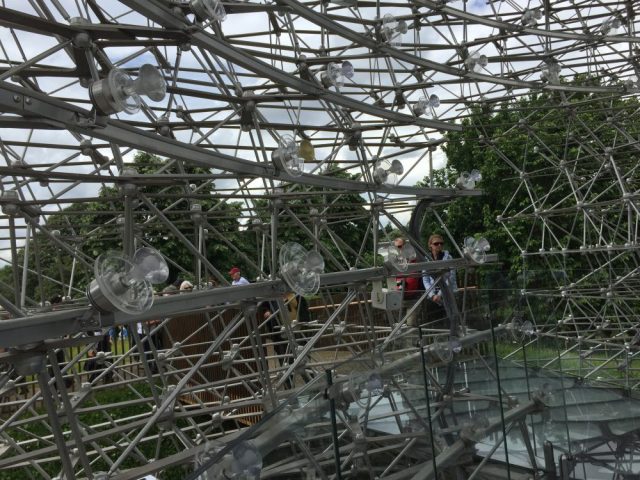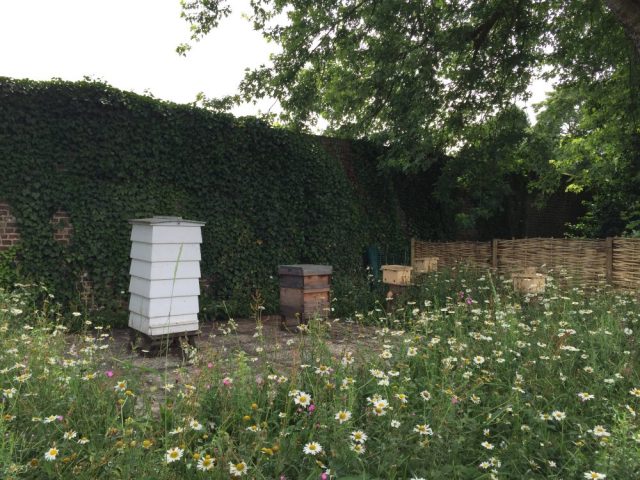Try to imagine yourself inside a bee colony. Close your eyes so that it’s dark. Imagine yourself to be one of many thousands now, crawling amongst the comforting scent and hum of your sisters. You can feel their vibrations speaking to you, shaking out many messages. The wax combs carry throbbing tales of flowers for the taking, of your queen, of work to be done. You touch a sister with your antennae and she stops to give you sweet nectar; you pick up a heady regal waft as she does so, and you know your queen is amongst you.
Communication – vibrations – messages – the busy world inside a hive. The magnificently bearded artist Wolfgang Buttress has tried to recreate some of this experience for visitors in his new artwork at Kew Gardens, ‘The Hive‘. Ealing beekeepers have even had some involvement in this as one of our members, Llyr Jones (Jonesy) looks after the bees at Kew. Jonesy also keeps bees on the rooftop of the John Lewis HQ – you can read about this on the ‘Meet our honey bees‘ section of their website.
The Kew website explains how The Hive works:
“The installation is made from thousands of pieces of aluminium which create a lattice effect and is fitted with hundreds of LED lights that glow and fade as a unique soundtrack hums and buzzes around you.
These multi-sensory elements of the Hive are in fact responding to the real-time activity of bees in a beehive behind the scenes at Kew. The sound and light intensity within the space changes as the energy levels in the real beehive surge, giving visitors an insight into life inside a bee colony.
With a wildflower meadow leading the way to The Hive, it will be a truly immersive, multi-sensory experience taking visitors on a journey, exploring the vital role of bees and other pollinators in feeding the planet.”
The activity levels of the bees are transmitted through ‘accelerometers’, vibration sensors which have been placed in a hive at Kew to measure the activity of the colony. The accelerometers pick up the bees’ vibrations and send them in real-time to the Hive installation. The changing vibrational signals then influence both the soundtrack and the lighting effects, so that the 1,000 LED lights which line the interior of the Hive become a visual representation of the bee colony’s activity.
I visited this week and took a few photos. Buggies are not allowed in the Hive, so bear in mind that the photos were taken one handed whilst holding a wriggling baby. He was very awake and fairly grumpy so my visit was not as long as I would have liked!
Visitors walk up to the Hive through a one-acre wildflower meadow specially planted with 34 native species which appeal to bees. Ironically I saw bees everywhere elsewhere in the gardens but not in the meadow. Awkward customers.
First you walk beneath the structure and can look up into it. For this reason Jonesy gave me the useful tip not to wear a skirt! A member of staff was enthusiastically giving short talks about bees and how the installation works. There are also bone conductor booths. These were very popular – you place a wooden stick in your mouth and can then feel four different examples of vibrations made by honey bees (including queen piping and the waggle dance) travelling through the booths to your skull. As I was holding Tommy, unfortunately I couldn’t try these out.
You then walk up a path through the meadow into the installation. There are signs like the one above to read on the way. I found it interesting that white clover is so important for UK bees.
Once inside the main structure above, there is a lovely gentle throbbing humming noise surrounding you. Meanwhile the LED lights perched on the walls glow on and off in ever-changing patterns. I liked to imagine that they represented individual bees touching or sharing nectar with each other. The ebbs and flows of the music are quite soothing and even Tommy seemed to enjoy it and calm down a little. Of course it gets quite crowded up there, but perhaps that helps recreate the intense atmosphere of a busy bee colony!
I discovered the bees themselves later, in a much quieter part of the gardens. Smaller bumblebee boxes have been set up (seen to the right of the photo) as well as the honey bee hives. I wonder if the bumbles have been successfully persuaded to stay in them, as they are fussy about using man-made homes!
There are many interesting facts to read about bees scattered amongst the gardens. Wolfgang Buttress and Kew have really put a lot of effort into raising people’s awareness of our lovely pollinators.
Scientists are discovering new information about honey bee communication all the time and it is clear that their use of vibrations to communicate goes well beyond the waggle dance. Wolfgang Buttress was inspired by the work of Dr Martin Bencsik, whose research team at Nottingham Trent University has pioneered using accelerometers within hives to detect and translate the vibrations made by the bees. For instance, the team has detected a a specific range and amplitude of vibrations used by bees when planning a swarm, up to two weeks before swarming occurs.
By the way, according to Nottingham Trent uni’s website Dr Bencsik currently works within an EU-funded consortium which includes research institutions, beekeeping associations and businesses. I hope his work will continue to be funded once we leave the EU.
More about The Hive:
- Listen to secrets of a honeybee hive in Kew’s latest sculpture – New Scientist, June 2016 – explains in more detail how the installation works.
- Feel the buzz: the album recorded by 40,000 bees – The Guardian, June 2016 – explains how The Hive’s soundtrack was created using bees, human vocals, cello, guitar, harmonica and autoharp












Wow!
LikeLiked by 1 person
I wonder if the accelerometers will ever be available for ordinary backyard beekeepers? I would love to know that a swarm was in the planning stages…sometimes you just can’t investigate a hive every week.
As for the referendum, future PMs will be appropriately cautious to ever call for such again. I like to keep up with European politics and just cannot wrap my head around the UK not being in the EU. My sympathies.
LikeLike
The BBC website says the scientists are hoping to build on the swarm research and “make a device that will warn bee keepers by email or text, giving them enough time to act.” http://news.bbc.co.uk/local/nottingham/hi/people_and_places/nature/newsid_9394000/9394955.stm – sounds great!
As well as the UK leaving the EU, there is a worry that other countries will copy us and hold their own referendums. Right-wing politicians in France and Holland have been calling for this.
LikeLike
So interesting! Thanks for writing about this. Andrea
LikeLike
Thanks Andrea, glad you liked it 🙂
LikeLike
It looks amazing and something that will hopefully make people understand a little more about bees and how important they are.
They should have put bird boxes up and just waited. I’ve had lots of bumblebee calls this year about bees in boxes!
LikeLike
Must be all those tree bumblebees!
LikeLike
This sounds like a very interesting experience and a great way to raise awareness of bees.
LikeLiked by 1 person
Wow, that is amazing! And you did a great job with the one-handed photos.😉
LikeLike
Thanks 🙂
LikeLike
A fascinating post! I would love to share this sensory experience, what imagination the creators must have. Amelia
LikeLike
The Hive will be at Kew till November 2017, so you have plenty of time to visit 🙂
LikeLike
That looks like an awesome place to visit.
LikeLike
Yes indeed. A long trip from Hawaii though.
LikeLike
It was a long way from Colorado, too.
LikeLike
Ah, I was hoping you would take him, but why no buggies? Because of the flooring? You’ve inspired me to visit…
LikeLike
I expect so, and also the installation gets pretty crowded as it’s one of the must-see things at Kew right now. Go on a weekday if you can.
LikeLiked by 1 person
Amazing piece. And, believe it or not, I’ve never seen bumblebee boxes before!
LikeLike
Thanks Bill. I should have got a better closeup of the bumblebee boxes for you! It’s unusual for them to be raised up off the ground like that.
LikeLike
Reblogged this on Let's Make a Bee Line and commented:
Cool Stuff. bees and Music.
LikeLike
Hi Emily
Fascinating article. Just re-blogged mid ‘Let’s Make a Beeline’ Have followed your blog and may visit for more info and would like to connect re our project.
https://makeabeeline.org/
LikeLike
Thanks – your project sounds fascinating. I’d be happy to do a post about it if you like?
LikeLiked by 1 person
That would be fantastic. Just blogged day 3. Need sleep now.
LikeLike
Pingback: The Hive at Kew | paul scribbles
Anything you want to know Emily drop me a line info@tintomusicandarts.org
Thanks for connecting up with us x
LikeLike
Fascinating post. I’m a bit late commenting but I hope to see The Hive myself in the next few days. I’m also thinking about going to one of the evening events there. It all looks well worth a visit!
LikeLiked by 1 person
Really enjoyed reading your description…the bees vibrating, humming almost like little monks all chanting rhythmically. Thank you for visiting my blog.
LikeLiked by 1 person
Thank you! I enjoyed your blog too.
LikeLike
Pingback: Middlesex Federation Day: Dr Martin Bencsik – “Monitoring honeybee colony activity with accelerometer sensors” | Adventuresinbeeland's Blog
Pingback: Eden project bee exhibition – and a bee update | Adventuresinbeeland's Blog
Pingback: Autumnal adventures at Kew | FolkestoneJack's Tracks